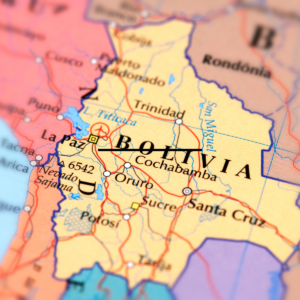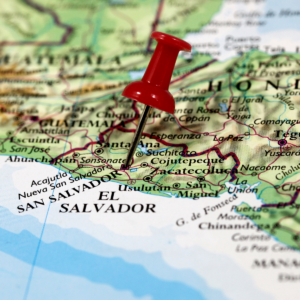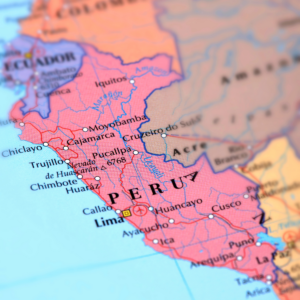Across Bolivia, El Salvador and Peru, the spread of disinformation has disproportionately impacted marginalized communities amidst sociopolitical conflict in recent years.
Few initiatives have examined the ways in which disinformation spreads in local communities outside of capital cities, many of which lack access to diverse media outlets, reliable Internet connectivity or information in native languages.
To address this gap, local non-governmental organizations in each country conducted information ecosystem research in 2023 to examine how disinformation is impacting communities that receive minimal attention from mainstream media. The organizations studied local information ecosystems, or the networks of interactions between people and their information environments, by conducting a combination of focus groups, interviews and surveys.
The researchers asked university students, human rights defenders, influencers, union leaders, traditional and community-based journalists, and randomly selected samples of the general population about their media consumption habits, their trusted information sources, and the actors they believe spread disinformation. While trends varied in each local community, the research indicated a key throughline: disinformation tended to intensify during periods of socio-political conflict.
Disinformation in Bolivia grew particularly notable during recent periods of sociopolitical crisis surrounding the country’s contested 2019 electoral process and the COVID-19 pandemic. These events contributed to widespread fear – residents in Santa Cruz, for instance, burned 5G antennas because they falsely believed the antennas spread COVID-19. The rise in protests following the 2019 elections have also translated into physical violence, including attacks against journalists. This trend has led more journalists to practice self-censorship out of fear for their safety, in turn limiting freedom of expression.
 In 2023, Chequea Bolivia conducted information ecosystem research in Villa Tunari, Montero and Yacapani, three towns on the border of Santa Cruz and Cochabamba. The locations were chosen due to the zone’s continuous conflict, the presence of narcotrafficking and self-censorship among members of the press. A link between this context and disinformation emerged: Chequea Bolivia found that 41% of the randomly selected sample of the population they surveyed believed information was manipulated during times of conflict, while 36.2% thought it promoted confusion.
In 2023, Chequea Bolivia conducted information ecosystem research in Villa Tunari, Montero and Yacapani, three towns on the border of Santa Cruz and Cochabamba. The locations were chosen due to the zone’s continuous conflict, the presence of narcotrafficking and self-censorship among members of the press. A link between this context and disinformation emerged: Chequea Bolivia found that 41% of the randomly selected sample of the population they surveyed believed information was manipulated during times of conflict, while 36.2% thought it promoted confusion.
Enid López, chief fact checker for Chequea Bolivia, says that disinformation intensified in these three communities when the 2019 electoral conflict broke out due to their key roles as hubs for political parties that maintain ongoing tensions. The zone stands out for its instances of physical violence and even mortalities that link back to disinformation spread on social media.
In Montero, for instance, disinformation circulated rampantly on WhatsApp in October 2019, and a conflict broke out when a pro-government group arrived to lift a blockade imposed on a bridge by those demanding the annulment of the elections. The image of a burnt body went viral with false claims that it was taken minutes prior in Montero and belonged to a young opponent attacked by government supporters. The conflict in Montero turned violent and resulted in two deaths, exemplifying the impact of disinformation during moments of sociopolitical unrest.
López says that both local and national government actors frequently target human rights activists in Montero through disinformation; however, the government’s disinformation campaigns are not limited to a particular ideological leaning.
“In the in-depth interviews we conducted, [participants] told us that it is the government that spreads disinformation about human rights issues and about the work done by human rights activists in order to discredit their work,” she said.
Finally, López says that research participants in this zone tended to highly trust the information they receive from family and friends. However, this trust increases their likelihood to spread disinformation, particularly through channels like WhatsApp, because they do not believe their close circles would share harmful information and thus rarely consider it necessary to verify before sharing.
According to Juan Carlos Uribe, coordinator of Chequea Bolivia, this reality highlights the need for greater access to education in fact checking and in digital literacy, particularly among journalists at hyperlocal media outlets.
Another strategy, Uribe says, would be to “create alliances between the hyperlocal media outlets and those in the central part of Bolivia, in the important cities, so that training could be ongoing and not just at one time.”
In 2023, San Miguel, a key department in eastern El Salvador, saw high rates of disinformation following the national government’s measure to reduce the country’s 262 municipalities to 44, thereby impacting voting and political representation.  Media outlet Infodemia conducted information ecosystem research in San Miguel to examine this trend and observed that 68% of the local population interviewed had experienced economic, psychological and social impacts connected to disinformation.
Media outlet Infodemia conducted information ecosystem research in San Miguel to examine this trend and observed that 68% of the local population interviewed had experienced economic, psychological and social impacts connected to disinformation.
Infodemia’s research identified the executive branch of national government and other government-related actors as key sources of disinformation, particularly related to political issues, over the last year. They found that the government’s media censorship and efforts to spread disinformation through propaganda have contributed to the spread of rumors, biased coverage and information deserts.
Angelica Cárcamo, director of Infodemia, says this type of disinformation often surrounds the issues citizens are most concerned about in daily life. For instance, she says the national government has spread narratives claiming the current economic crisis is a product of a global crisis generated by droughts or international conflict without recognizing the lack of comprehensive domestic policies to ensure food security or sufficient housing.
“The police or the ministry of security sometimes like to say that in El Salvador, there are no more homicides,” Cárcamo said. “But sometimes there are confrontations. When gang members die, they don’t count them as part of that statistic.”
As in Bolivia, Cárcamo says Infodemia’s information ecosystem research identified a clear link between disinformation and widespread fear. This fear centered around three main themes in San Miguel: the COVID-19 pandemic, the active Chaparrastique volcano and the nationwide “state of exception” that the national government first imposed in March 2022.
The state of exception began following a rise in homicide rates, but the government has extended it to restrict human rights, including freedoms of movement and expression. Cárcamo says disinformation has played a key role in narratives justifying the state of exception to gradually close democratic spaces and spread false perceptions around the motives behind detainees’ arrests.
“The government says that it respects human rights, but it does not talk about the abusive detentions it is committing against adolescents,” Cárcamo said.
As in Bolivia, Infodemia found that disinformation feeds directly into community fear by promoting alarmist framing and discouraging community members from questioning official discourse around issues like the state of exception or the pandemic.
In Peru, the impact of disinformation has primarily surrounded issues related to electoral processes, contributing to low trust in the press and minimal confidence in elections.
 To examine trends in trust in news in southern Peru, the Instituto de Estudios Peruanos (IEP) conducted information ecosystem research in Apurímac, Arequipa, Ayacucho, Cusco, Ica, Moquegua, Puno, and Tacna in the first half of 2023. Their research found that 78% of those surveyed had read news or received information that they later realized was false.
To examine trends in trust in news in southern Peru, the Instituto de Estudios Peruanos (IEP) conducted information ecosystem research in Apurímac, Arequipa, Ayacucho, Cusco, Ica, Moquegua, Puno, and Tacna in the first half of 2023. Their research found that 78% of those surveyed had read news or received information that they later realized was false.
Patricia Zárate, the principal researcher and director of opinion for IEP, says the 2021 presidential elections between Keiko Fujimori and Pedro Castillo sparked a notable discourse of disinformation in the traditional media. Votes were close between the two candidates, leading Fujimori to claim that the results indicating her loss were fraudulent.
Given Fujimori’s ties to the establishment, Zárate says key media outlets, many of which are located in Lima, also began to question the validity of the elections, even though international organizations observing the elections confirmed there was no fraud. Outlets such as the television station Willax, a channel based in Lima, shared publications on social media networks suggesting that deceased individuals were counted among votes and implying the possibility of electoral fraud. Other outlets and individual journalists also shared similar, unverified content through their own social media accounts.
“They invited analysts who said that there could be fraud, they put this on television, they did interviews, they gave space to small groups that were protesting because there was fraud,” Zárate said, referencing trends she observed among traditional outlets.
Zárate says that disinformation spread through traditional media tends to produce a more notable impact than that on social or digital media, drawing a contrast to disinformation trends in Bolivia and El Salvador.
According to Zárate, disinformation has particularly impacted trust in the southern zone of Peru in connection to the 2021 presidential elections and 2022 sociopolitical protests, which responded to Pedro Castillo’s attempt to temporarily dissolve the congress to avoid impeachment. As the south represents a diverse area where many residents do not speak Spanish as their native language and live in rural communities, Zárate says many feel misrepresented by national media coverage.
According to Zárate, the implications of disinformation extend beyond responses to election results, contributing to authoritarian tendencies and the breakdown of democracy long-term by discrediting institutions.
“There has to be a balance of powers, and in general, I think that what this kind of news does is says, ‘everything is wrong,’” Zárate said.
To effectively mitigate these trends in disinformation across Bolivia, El Salvador and Peru, the researchers in each country highlighted the importance of capacity-building in media literacy for civil society members, community leaders and journalists alike, to help them become more critical information consumers.
Cárcamo says forming alliances between media outlets and universities, community organizations and human rights defenders is key to effectively mitigate disinformation at the local community level, strengthen the rigor of the press and begin educating the next generation of youth.
“It is important to create a network of support with other groups or collectives, not only at the national level, but also at the regional level to have a greater impact,” she said.
Finally, Cárcamo says a local approach to researching information trends outside of capital cities, in collaboration with the communities, is essential to understand a country’s population more inclusively and then equip them with the skills to respond to disinformation to guarantee their rights.
“The more citizens we can have who are critical, and critical of their social environment, the more who can make better decisions,” Cárcamo said.
*Based in Washington, D.C., Julia Knoerr is a Senior Program Associate on the South America team at Internews. Her work focuses on studying disinformation trends and expanding information access, particularly among marginalized communities in Latin America.